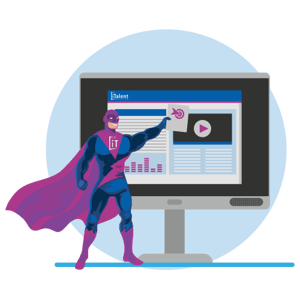The five levels of data visualization and reporting maturity – how does your organization stack up?
 In a world where data increasingly dictates business decisions, leveraging it effectively is key. Imagine the impact when complex data gives way to lucid insights, guiding a company towards smarter, faster, and more effective decisions.
In a world where data increasingly dictates business decisions, leveraging it effectively is key. Imagine the impact when complex data gives way to lucid insights, guiding a company towards smarter, faster, and more effective decisions.
No matter where you are in your data management journey, now is the best time to uplevel your processes, policies and technology to get ahead of the changes taking place in 2024 and beyond. Data visualization and reporting plays a key role in leadership’s ability to position their enterprise to seize today’s opportunities and prepare for tomorrow’s.
In this article, I describe the five levels of data visualization and reporting maturity based on our team’s experience with the world’s leading brands. For each stage in the spectrum, I provide some concrete steps for advancing to the next level.
Level 1: Ad-hoc and reactive reporting
This stage is characterized by an unsystematic approach to data management, where data is often used sporadically and in response to specific, immediate queries. Organizations at this level typically rely on basic tools like spreadsheets, and data analysis is limited to creating one-off reports that address singular issues as they arise. This ad-hoc approach, while sometimes effective for small-scale or short-term needs, significantly limits an organization's ability to harness data for strategic decision-making.
Consider a small retail business that operates mostly on gut feeling and historical sales figures noted in spreadsheets. They generate reports only when there's an immediate need, like a sudden dip in sales, but lack a consistent approach to monitor sales trends or customer behavior over time. This reactive stance often leaves them a step behind market shifts and competitors.
To move beyond this initial stage, organizations must establish more systematic data collection and analysis practices. That includes regular data recording, setting up basic data storage solutions, and beginning to transition from mere data collection to data analysis for insights. Embracing tools that offer more than just spreadsheet functionalities, such as simple business intelligence (BI) software, typically marks the first step towards a more structured and proactive data management approach.
Level 2: Descriptive reporting - 'What happened?'
Once we advance to the second level of the data maturity spectrum, we encounter descriptive reporting. This stage focuses on systematically analyzing past events to understand 'What happened?' in a given situation. Organizations at this level have moved towards regular, structured data reporting by employing basic analytics to interpret historical data. This level is also marked by repeatable analysis processes that provide a retrospective view of business performance, such as monthly sales reports or yearly market trends.
.png?width=768&height=432&name=5-levels-visualization-reporting-infographic(sm).png)
A typical example of this level could be a mid-sized manufacturing company that regularly reviews production data to assess performance over the previous quarter. It uses descriptive analytics to identify patterns in production efficiency, for instance, or to pinpoint periods of high demand. While this approach provides valuable insights into past performance, it is still primarily backward-looking and does not anticipate future trends or offer strategic foresight.
The technological requirements at this stage involve more sophisticated data storage solutions than basic spreadsheets. Organizations typically adopt basic analytics software that can aggregate and analyze large data sets to provide clearer insights into historical trends. This might include tools for data visualization, like dashboards that display key performance indicators (KPIs) and trends over time. Developing a more formalized approach to data governance and quality assurance becomes important at this level to ensure the reliability and consistency of the data being analyzed.
Case study: Read about how we accelerated time-to-insight for a leading social media platform
Level 3: Diagnostic reporting - 'Why did it happen?'
Moving up the maturity spectrum, we arrive at Level 3: diagnostic reporting. This stage is about delving deeper into data to discover why something happened. Organizations at this level analyze.jpg?width=300&height=300&name=data-visualization-1(sm).jpg) relationships between different variables to uncover the underlying causes of observed trends. This analytical approach goes beyond describing what happened to explore the reasons behind it and provide more nuanced insights for decision-making.
relationships between different variables to uncover the underlying causes of observed trends. This analytical approach goes beyond describing what happened to explore the reasons behind it and provide more nuanced insights for decision-making.
The perfect example of this level comes from the work iTalent did with Microsoft. Tasked with enhancing the effectiveness of Microsoft's digital customer engagement platform, iTalent was faced with the challenge of overcoming the platform's limited out-of-the-box analysis capabilities. The solution was to implement a sophisticated middleware software designed to collect, analyze, and generate highly specialized and customizable reports based on a myriad of data elements.
The results were transformative. iTalent’s solution enabled Microsoft to produce extremely detailed and tailored reports, offering deep insights into the operation and success of various digital communities. The level of granularity in analysis allowed Microsoft to scrutinize and improve its digital engagement strategies to a whole new level. The success of this project led to further collaborations, including with teams like the Minecraft support group.
Case study: Read about how we used AI to enhance the customer insights of Microsoft's Power BI user community
The technological capabilities needed at this stage involve the use of advanced reporting tools and techniques. Organizations that have reached this level have started employing more complex data analytics software that can handle multivariate analysis and provide more sophisticated data visualization options. This might include heat maps, scatter plots, or correlation matrices to identify and visually represent relationships between different data points.
Level 4: Predictive analytics: 'What is likely to happen?'
This stage is where data starts making predictions. It's about harnessing historical data to forecast trends and potential outcomes. In short, it relates to answering the critical question, 'What is likely to.jpg?width=300&height=300&name=data-visualization-3(sm).jpg) happen?' This level of analysis allows businesses to anticipate market movements, customer behavior, and operational efficiencies and transition from reactive decision-making to a proactive strategy.
happen?' This level of analysis allows businesses to anticipate market movements, customer behavior, and operational efficiencies and transition from reactive decision-making to a proactive strategy.
Consider the automotive industry, where a leading car manufacturer implements predictive analytics to forecast vehicle failures before they occur. By analyzing patterns in warranty data and vehicle sensor readings, they predict potential issues to enable proactive maintenance and enhanced customer satisfaction. This reduces downtime and also streamlines inventory management for spare parts.
Related reading: Elevate your decision-making with Power BI’s AI capabilities
Key technologies driving this level of analytics include AI and machine learning. These technologies allow organizations to process large volumes of data and identify patterns that human analysts might miss. Machine learning algorithms can analyze past performance to predict future outcomes, while AI brings in advanced capabilities like neural networks that simulate human decision-making processes.
Level 5: Prescriptive analytics: 'How can we make it happen?'
At the pinnacle of data maturity is Level 5: prescriptive analytics. This stage transcends predictive capabilities by focusing not just on what will happen, but on what should be done about it. This is where data analysis becomes actionable intelligence, guiding organizations in shaping their future through informed, strategic decisions. Prescriptive analytics combines the power of real-time data, advanced analytics, and machine learning to forecast scenarios and recommend specific actions.
A compelling example of prescriptive analytics in action is seen in the healthcare industry. Major hospital networks utilize prescriptive analytics to optimize patient flow and resource allocation. By analyzing real-time patient data, historical admission rates, and staffing levels, the system provides recommendations on resource distribution to minimize wait times and improve patient care. This proactive approach enhances patient experiences and streamlines operational efficiency, leading to significant cost savings and better health outcomes.
The technological integration required for prescriptive analytics is multifaceted. It demands a robust AI framework capable of complex decision-making algorithms, real-time data processing for instantaneous analysis, and holistic systems integration to ensure a seamless flow of data across various platforms. This level of analytics relies heavily on advanced AI techniques, including deep learning and neural networks, to simulate nuanced decision-making processes.
How does your organization stack up?
In our exploration through the levels of data visualization and reporting maturity, we've traversed from the ad-hoc rerporting of Level 1 to the sophisticated prescriptive analysis of Level 5. Each level brings you a step closer to a data-driven future, where decisions aren’t reactions to the past but informed predictions and prescriptions for success. Now, it’s time to understand where your organization stands on this spectrum.
Contact me at itbi@italentdigital.com to book a free consultation and discover how iTalent can elevate your data capabilities!
You may also like:
Embrace a holistic approach to customer obsession
7 ways to unlock new business value during economic turbulence
How to use data to build a business case for change management



